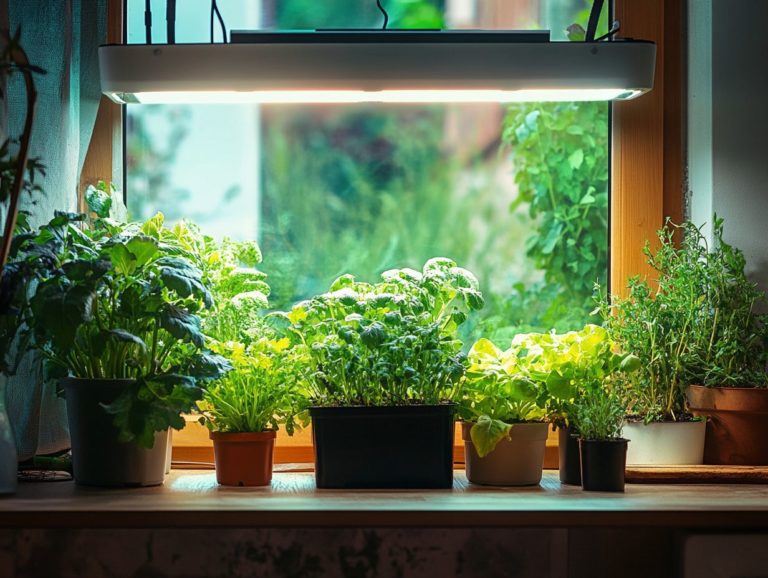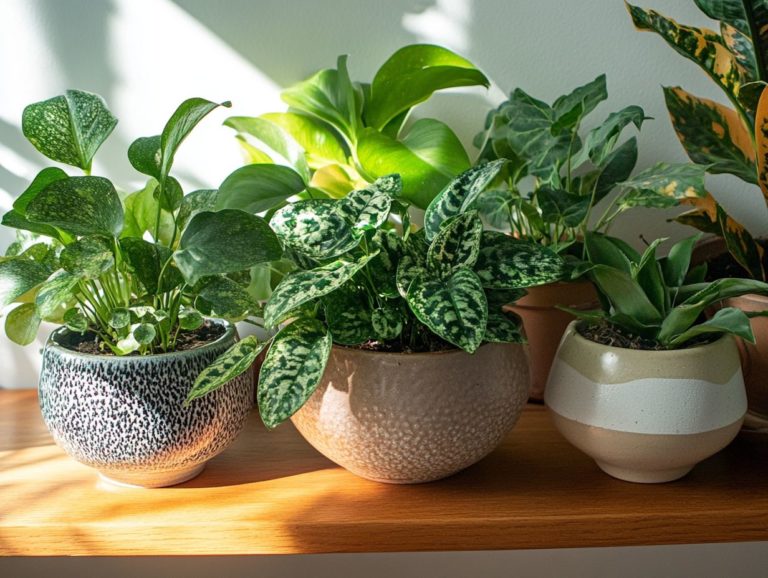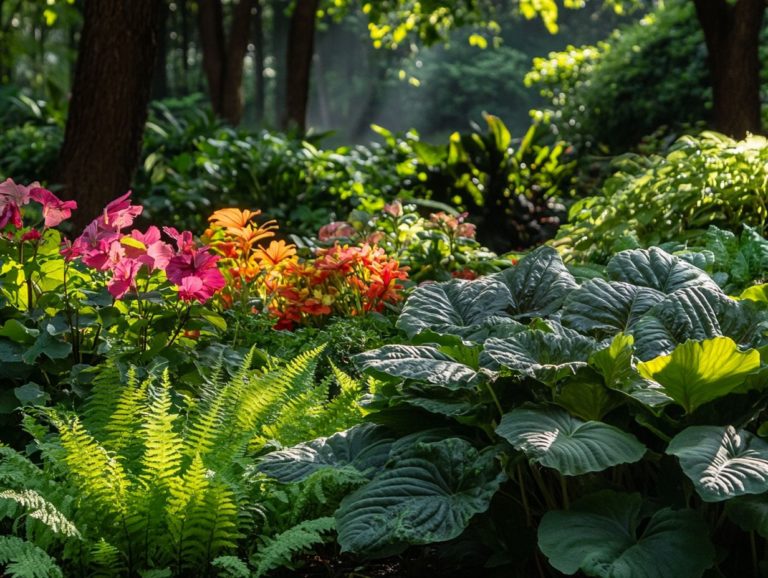Low Light Indoor Plants: Top Choices
Looking to enhance your indoor space with some indoor greenery but concerned about low light conditions? You re in for a treat!
This article delves into the finest low light indoor plants that flourish even in the shadiest corners of your home, including beautiful houseplants that are easy to care for. From the hardy Snake Plant to the striking Peace Lily, you have a plethora of options to infuse beauty and vitality into your environment.
You’ll also find essential tips on caring for indoor plants, their benefits, and common pitfalls to steer clear of. Keep reading to discover your ideal plant companion, whether it be a flowering plant or a low-maintenance houseplant!
Contents
- Key Takeaways:
- 1. Snake Plant
- 2. ZZ Plant
- 3. Pothos
- 4. Spider Plant
- 5. Peace Lily
- 6. Chinese Evergreen
- 7. Dracaena
- 8. Philodendron
- 9. English Ivy
- 10. Cast Iron Plant
- 11. Boston Fern
- 12. Aloe Vera
- 13. African Violet
- 14. Chinese Money Plant
- 15. Rubber Plant
- What Are the Benefits of Having Indoor Plants?
- Frequently Asked Questions
- What are some top choices for low light indoor plants?
- Can low light indoor plants survive in rooms with no natural light?
- Do low light indoor plants require any special care?
- Can I place low light indoor plants in high traffic areas?
- Which low light indoor plants are safe for pets?
- Can I grow herbs in low light indoor conditions?
Key Takeaways:
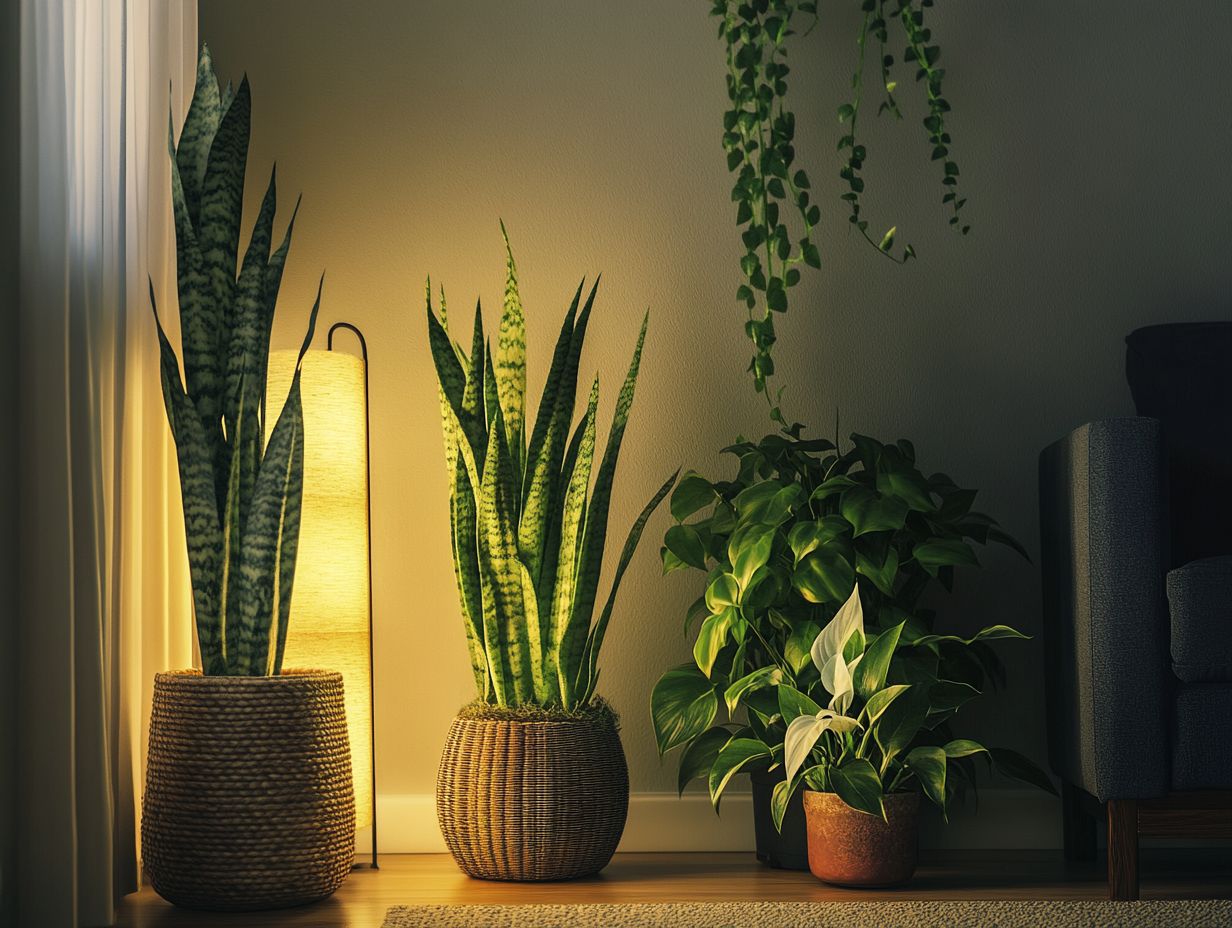
- Beautiful and low-maintenance, low light indoor plants are perfect for any home or office setting, especially if you’re considering popular houseplants.
- Some of the top choices for low light indoor plants include snake plants, ZZ plants, and pothos, which are all exceptional examples of easy-care plants.
- When caring for low light indoor plants, it is important to consider factors like watering, lighting, humidity levels, and soil conditions for their optimal health and growth.
1. Snake Plant
The Snake Plant, or Sansevieria, is the ultimate indoor companion that thrives effortlessly in low-light conditions, making it a favorite among indoor gardening enthusiasts. It’s no wonder this beauty has become a favorite for both novice indoor gardeners and anyone seeking low-maintenance houseplants with lush green leaves.
With its striking vertical growth, this resilient plant adapts to various lighting situations while demanding minimal care. One of the most attractive features of this plant is its ability to survive on intermittent watering, allowing even the busiest individuals to enjoy gorgeous plants without the burden of intricate care routines.
Regarding placement, the Snake Plant flourishes in bright, indirect light but is also perfectly content in dimmer spaces, making it a versatile addition to any home. To optimize its health, consider positioning it near a window dressed with sheer curtains or in a well-lit room where it can enjoy bright indirect light. This not only enhances its growth but also highlights its unique architectural form.
Beyond its aesthetic appeal, the Snake Plant purifies indoor air and infuses a touch of nature into urban settings, solidifying its status as a beloved choice among plant enthusiasts interested in air purification.
2. ZZ Plant
The ZZ Plant, or Zamioculcas zamiifolia, presents an exceptional choice for indoor gardening enthusiasts like you, especially if you appreciate easy-care plants that flourish in low-light environments while injecting vibrant colors into your space.
Its glossy, dark green leaves not only elevate the aesthetic allure of your home or office but also play a role in air purification, enhancing your indoor decoration. The ZZ Plant is remarkably resilient, thriving even under less-than-ideal conditions perfect for those with a busy lifestyle.
With minimal water requirements, it s essential for you to let the soil dry out completely between waterings to avoid root rot. This hardy plant cleverly stores water in its special parts that store water, enabling it to withstand extended periods of drought, making it an excellent option for those new to gardening.
3. Pothos
Pothos, or Epipremnum aureum, is a gem in the world of indoor gardening, celebrated for its stunning trailing vines and remarkable adaptability in low-light environments. It s no wonder it has become a beloved choice for those who appreciate beautiful houseplants that thrive even in low light.
Among the many captivating varieties, Golden Pothos shines with its striking multicolored leaves and vibrant golden hues that effortlessly catch the eye. The Neon Pothos captivates with its luminous lime-green foliage, adding a refreshing splash of color to your space. Each variety possesses its own unique charm, guaranteed to brighten up any room.
For optimal growth, these popular houseplants thrive in humidity levels between 40% and 70%. This range keeps them lush and vibrant. Remember to water them when the top inch of soil feels dry; this simple practice encourages healthy root development and prevents overwatering, ensuring these beauties continue to thrive in your indoor environment.
4. Spider Plant
The Spider Plant, or Chlorophytum comosum, is a cherished favorite among indoor plants, known for its amazing air purification and delightful arching fronds. It’s the perfect choice for anyone who values both aesthetic appeal and low-maintenance care.
This resilient beauty thrives best in bright, indirect light, soaking up just the right amount of illumination without risking scorch on its delicate leaves. It prefers a humidity level reminiscent of its natural habitat but is forgiving enough to allow for slight drying between waterings, making it an easy-care plant for busy schedules.
As your Spider Plant flourishes, it will produce adorable offshoots, affectionately known as pups, which can be easily propagated to expand your indoor greenery family. This plant also cleans the air by filtering out pollutants, making it a stunning and beneficial addition to your living space.
5. Peace Lily
The Peace Lily (Spathiphyllum) is an enchanting flowering plant that will transform your space, flourishing effortlessly in low-light indoor settings. With its stunning white blooms, it serves as an exquisite addition to your home’s greenery, especially in areas with higher moisture levels.
This resilient plant adapts seamlessly to various care routines, requiring minimal effort on your part while rewarding you with lush foliage and the occasional flourish of flowers. Its glossy, dark green leaves not only elevate the aesthetic of any room but also enhance air quality, making it a standout among popular houseplants.
Remember, the Peace Lily can be harmful to pets, so place it carefully to ensure a safe and harmonious living space.
6. Chinese Evergreen
The Chinese Evergreen (Aglaonema) is your go-to indoor plant, celebrated for its stunning decorative foliage and remarkably low-maintenance nature, making it perfect for busy lifestyles. If you appreciate beauty but lead a hectic life, this resilient plant thrives effortlessly in various lighting conditions even those dimly lit corners of your home.
You ll find a delightful range of varieties, each boasting unique leaf patterns and colors. For instance, the striking ‘Silver Bay’ or the eye-catching ‘Red Aglaonema’ both are sure to elevate your space.
Caring for this indoor gem is a breeze. Water it when the top inch of soil feels dry, and keep an eye on humidity levels to prevent pesky leaf browning issues. The Chinese Evergreen excels at purifying indoor air, filtering out toxins like formaldehyde and benzene, making it not just a pretty face but a functional companion as well.
For optimal growth, consider using a well-draining potting mix and give it an occasional boost with fertilizer during the growing season. This simple care routine can significantly enhance its overall health and vibrancy, ensuring it remains a standout feature in your home.
Start your indoor garden today with these stunning plants!
7. Dracaena
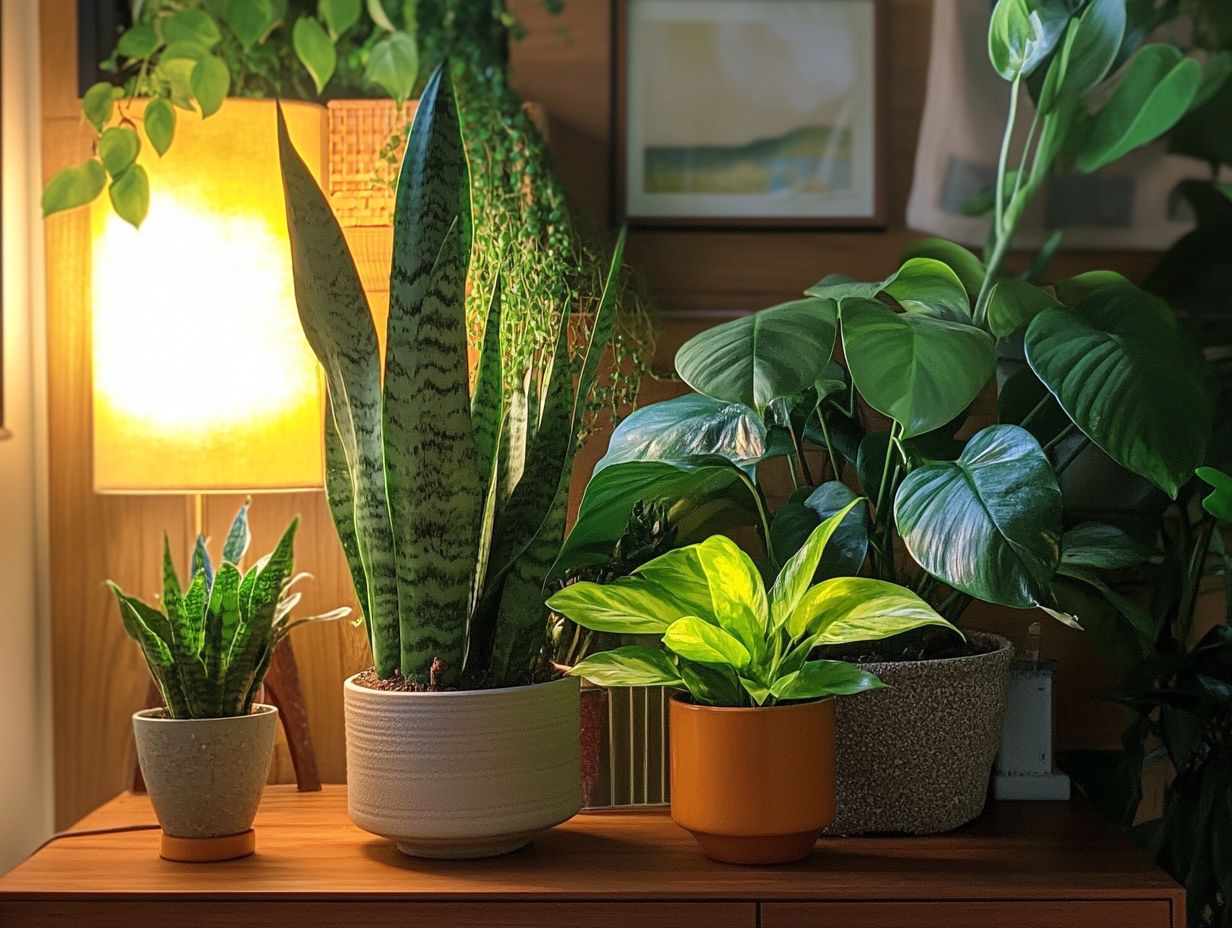
Dracaena is a striking indoor plant known for its beautiful leaves. It’s a perfect choice for low-light areas and is easy to care for, making it an excellent option for your indoor garden especially if you re seeking low-light companions that are also low-maintenance.
Among the various varieties, like Dracaena marginata and Dracaena fragrans, each brings its own unique leaf shapes and colors, enriching the aesthetic appeal of any space. These plants thrive in indirect sunlight and can adapt to dimmer environments, making them perfect for apartments or offices that may not always receive bright light. For those looking to enhance their indoor greenery, check out the top 5 shade-tolerant indoor plants.
Watering regularly is important; allow the top inch of soil to dry out between waterings for optimal plant health. Opt for well-draining potting soil to prevent root rot, a condition caused by too much water that can damage the plant’s roots. This supports the robust growth and longevity of these resilient houseplants, ensuring they thrive in your indoor gardening setup.
8. Philodendron
Philodendron plants are celebrated for their lush green leaves and graceful trailing vines. Elevate your decor with these vibrant beauties! They thrive in low-light conditions, making them popular choices in indoor gardening.
The Philodendron Brasil truly shines with its unique foliage. Its vibrant heart-shaped leaves, embellished with striking yellow and green variegation, are impossible to overlook. This species thrives in warm, humid environments, often preferring humidity levels above 50 percent to mirror its tropical roots.
To keep your Philodendron Brasil in peak condition, mist the leaves regularly and position it near a humidifier to maintain the humidity-loving plant s health. Water it when the top inch of the soil feels dry, ensuring it doesn t languish in waterlogged conditions, which can be detrimental to its health.
For optimal growth, don t shy away from periodic pruning of those leggy stems to encourage a bushier appearance. A little gentle guidance for the vines on a trellis can create a stunning visual display, enhancing the overall charm of your indoor space filled with beautiful houseplants.
9. English Ivy
English Ivy (Hedera helix) is the perfect climbing plant to add elegance to your space. It thrives in low-light conditions and doubles as an effective air purifier, making it a practical choice for any room.
This resilient species enjoys moderate humidity, which is why it feels right at home in bathrooms or kitchens where moisture levels are typically higher. Regular misting can keep your English Ivy vibrant and healthy, ensuring those leaves stay lush.
Be mindful of common pitfalls like overwatering, which can lead to root rot and other unwelcome complications. Allow the soil to dry slightly between waterings to keep your plant happy. Keep an eye out for pests like spider mites and aphids, as these nuisances can detract from its beauty.
Implement a proactive pest management routine to maintain the lush appearance of your English Ivy and enjoy its charm for years to come.
10. Cast Iron Plant
Meet the Cast Iron Plant it’s the ultimate tough guy of indoor plants! Renowned for its remarkable toughness, it thrives effortlessly in low-light indoor environments. It’s an ideal choice for anyone looking for a resilient indoor plant that demands minimal care and can handle neglect.
This hardy plant flourishes even in the dimmest of corners, so you won t have to fret over finding the perfect spot. Watering? Keep it to a minimum; let the soil dry out between sessions, as the Cast Iron Plant is forgiving when it comes to moisture needs.
Its impressive tolerance to low humidity means it can adapt beautifully to almost any indoor climate, whether it’s a snug apartment or a bustling office space.
With its lush green leaves and sturdy structure, this plant not only elevates the aesthetic appeal of any setting but also showcases an impressive ability to thrive despite the occasional oversight. Don’t miss out on the chance to brighten your space!
11. Boston Fern
The Boston Fern (Nephrolepis exaltata) is a stunning, humidity-loving plant. It boasts vibrant colors and delicate fronds, making it a prized addition to your indoor greenery, especially in spaces with elevated humidity levels.
To flourish, this fern craves a consistent humidity level, ideally between 50% and 70%. Consider placing it in a bathroom or using a humidifier to provide the moisture it needs. Water regularly, but let the top inch of soil dry out between sessions to prevent overwatering the roots.
If you’re caring for the Boston Fern in low-light conditions, remember to rotate the pot occasionally. Avoid direct sunlight, which can scorch its delicate leaves. Instead, aim for bright, indirect light to encourage healthy growth while maintaining its lush, vibrant appearance.
Bring home a Boston Fern today and elevate your indoor greenery!
12. Aloe Vera
Aloe Vera isn t just a low-maintenance indoor plant; it s a true gem prized for its air purification abilities and the soothing gel it produces. This makes it a versatile addition to any indoor space.
This succulent thrives beautifully even in low-light conditions, making it an ideal choice for homes and offices where natural sunlight is scarce. With minimal care requirements, it flourishes with a mere watering every three weeks, perfect for busy individuals who want to reap the benefits without dedicating extensive time to upkeep. For those looking to enhance their indoor gardening experience, consider the top 10 grow lights for indoor plants.
Beyond its striking appearance, Aloe Vera s gel is celebrated for its skin-soothing properties. It serves as a natural remedy for burns, cuts, and sunburns, providing a gentle and effective solution. Its adaptability to various indoor conditions makes it the perfect companion, seamlessly fitting into any lifestyle while enhancing both decor and well-being.
Try adding an Aloe Vera to your collection for a beautiful and functional plant!
13. African Violet
African Violet (Saintpaulia) is a beloved choice for indoor gardening enthusiasts. It s celebrated for its vibrant colors and delicate blooms that thrive in humidity-rich environments, effortlessly adding a splash of color to your space.
To help these charming plants truly flourish, provide bright, indirect light. This prevents leaf burn while encouraging healthy growth. For those interested in options that thrive in less natural light, consider the top 10 indoor plants for artificial light. Watering is equally essential; keep the soil consistently moist but never soggy, as overwatering can lead to root rot.
Aim for a humidity level of around 40-60% to mimic their native tropical habitat. Understanding their flowering habits can significantly enhance their beauty. Adopting specific care routines, such as using balanced fertilizers during their active growth phase, will encourage a more abundant display of blooms.
Enjoy a stunning array of blossoms throughout the year by adding an African Violet to your indoor garden!
14. Chinese Money Plant
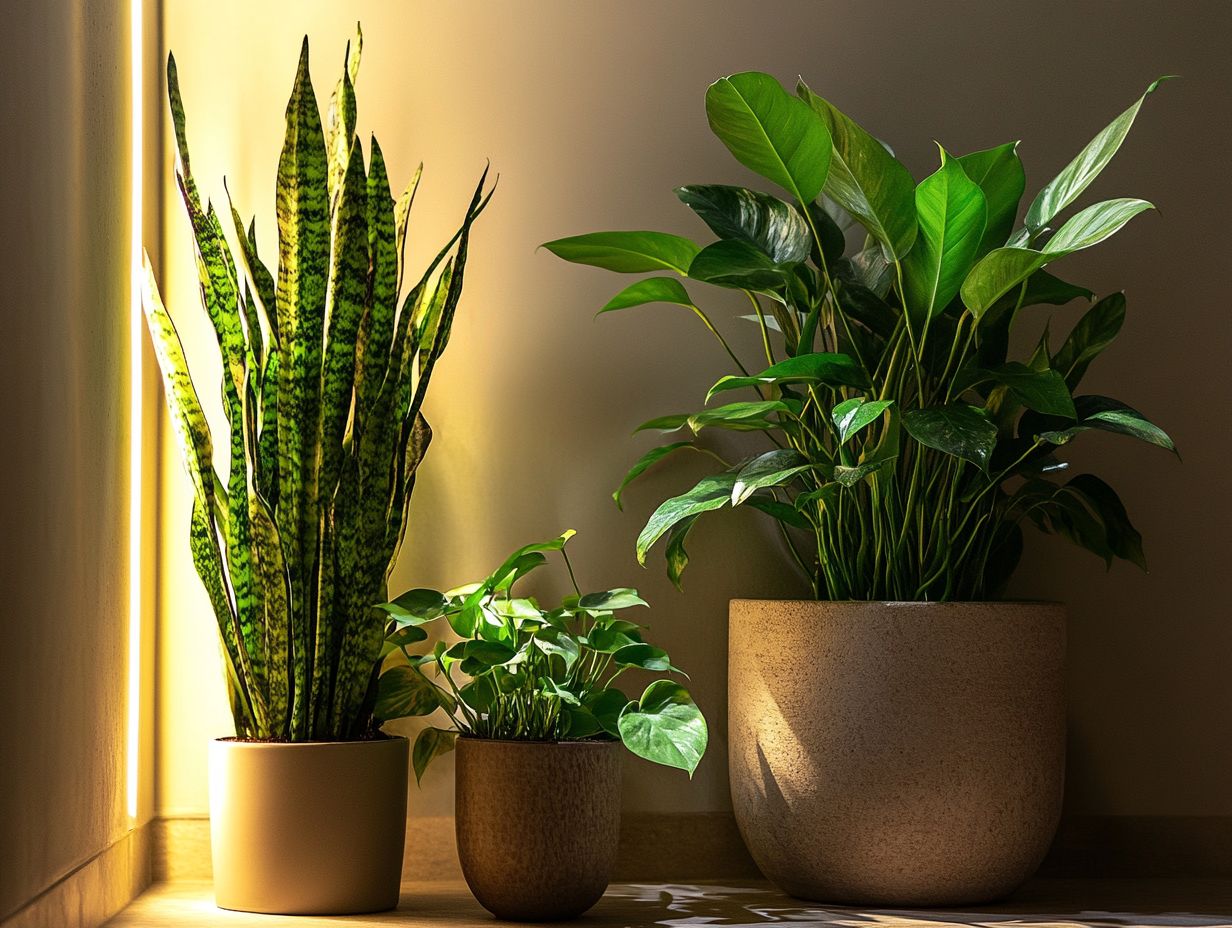
The Chinese Money Plant (Pilea peperomioides) is an enchanting choice for your indoor space. It’s renowned for its distinctive, round leaves that bring a touch of elegance to any decor, particularly in low-light environments.
This delightful plant flourishes in indirect sunlight, thriving best under bright, filtered light that allows its vibrant green foliage to truly shine. For those looking to enhance their indoor space, consider the top 5 indoor plants for east-facing windows. Maintaining a consistent watering schedule is crucial; letting the soil dry out between waterings encourages healthy growth, while overwatering could lead to root rot.
If you re eager to propagate, the Chinese Money Plant provides a wonderful opportunity to spread its charm. It produces offsets or ‘pups’ that can be easily separated and repotted, allowing you to share this beauty with friends or expand your own collection.
Its rising popularity in indoor gardening circles is no accident its low-maintenance nature combined with stunning aesthetics makes it a must-have for both budding and seasoned plant enthusiasts. Add a Chinese Money Plant to your home for a touch of elegance!
15. Rubber Plant
The Rubber Plant (Ficus elastica) shines indoors with its glossy leaves. It’s not just pretty; it boosts your space’s air quality!
To ensure it flourishes, position it where it can bask in bright, indirect sunlight. This encourages vibrant leaf development. Watering requires a balanced approach; allow the top inch of soil to dry out between waterings to avoid overwatering and root rot.
For added vitality, consider occasional misting to replicate its natural humid habitat.
Imagine breathing easier with this plant’s air-purifying magic, creating a healthier environment for everyone in your space.
What Are the Benefits of Having Indoor Plants?
Indoor plants are more than just decoration; they offer amazing benefits. They not only elevate your d cor but also purify the air, improving its quality naturally.
Plus, they foster a sense of tranquility and a deep connection to nature that enhances your overall well-being.
These green companions are a feast for the eyes with their vibrant colors and diverse foliage. They also play a vital role in alleviating stress. For example, peace lilies can significantly reduce airborne toxins, creating a healthier atmosphere.
Caring for plants like snake plants or pothos can transform into a soothing ritual that nurtures your mental health and emotional balance.
Engaging in indoor gardening cultivates a nurturing environment while encouraging mindfulness. It allows you to focus on growth and rejuvenation within your personal space, making it a meaningful practice.
How Do Low Light Indoor Plants Survive with Little Sunlight?
Low light plants, like the Snake Plant and ZZ Plant, thrive where others struggle. They re your go-to for dim spaces!
These remarkable plants have adaptations that enable effective photosynthesis, even in low-light environments. Their leaves often contain a high concentration of chlorophyll, enhancing their ability to absorb sunlight.
Energy storage is another impressive feature; many of these plants can store excess energy in their thick, fleshy leaves. This helps them sustain themselves during those darker days.
With their exceptional water retention abilities, they can weather longer dry spells, making them wonderfully resilient companions.
The Pothos and Peace Lily are perfect examples of this resilience, demonstrating how nature has equipped them to thrive in less-than-ideal lighting conditions.
What Are the Key Factors to Consider When Choosing Low Light Indoor Plants?
Choosing the right low light plant? Think about how easy it is to care for and how it fits your style.
When selecting low light indoor plants, consider factors like the plant’s care requirements and its adaptability to humidity levels.
Many low-maintenance houseplants thrive in these conditions, making the selection process both practical and rewarding.
Each plant has its own growth habits, ranging from sprawling to upright forms, significantly influencing how they elevate your living space.
For example, the resilient snake plant features tall, pointed leaves that provide striking vertical interest, while the trailing pothos can gracefully cascade over shelves, adding a touch of elegance.
Watering needs are another essential consideration. Some plants, like ZZ plants, prefer infrequent watering, ideal for those new to plant care. Others, such as peace lilies, flourish with a bit more moisture.
Opting for plants that tolerate typical indoor humidity levels, like the hardy spider plant, will contribute to a healthier environment.
By understanding these characteristics, you can cultivate a lush, vibrant atmosphere even in the dimmer corners of your home.
Ready to bring these benefits home? Start exploring today!
How Can One Care for Low Light Indoor Plants?
Caring for low-light indoor plants means understanding their unique needs, such as how often to water them and ensuring the soil dries out between waterings. You’ll also want to provide adequate humidity for those plants that thrive in it.
To achieve the best results, consider sticking to a watering schedule of every two weeks. Let the top inch of soil dry out thoroughly before you water again. This approach mimics their natural habitat, where excess water can lead to root rot.
Optimal soil conditions call for a well-draining potting mix infused with materials like perlite or sand. These enhance aeration while retaining just the right amount of water. Maintaining humidity can be as simple as placing a pebble tray filled with water beneath the plant pot or misting the leaves regularly.
For example, snake plants and pothos are good choices. Implementing these measures can significantly promote healthy growth, ensuring your indoor environment meets the specific needs outlined in understanding indoor plant light needs for these adaptable green companions.
What Are the Common Mistakes to Avoid When Caring for Low Light Indoor Plants?
Common mistakes in caring for low-light indoor plants often include overwatering, neglecting humidity levels, and misjudging the light requirements of each plant. These errors can greatly affect the health and longevity of your greens.
Recognizing each plant’s needs is essential. Overwatering can lead to root rot, so it’s important to let the topsoil dry out between waterings. Humidity plays a vital role as well; many low-light plants flourish in humid environments. For those looking to brighten their spaces, consider the top 5 indoor plants for bright spaces. You can also use a humidifier or a pebble tray to create a suitable atmosphere.
Misjudging the amount of light your plants receive can stunt their growth and vibrancy. By regularly assessing their surroundings and considering using light shades for indoor plants, you’ll ensure that your indoor garden thrives with healthier, happier plants.
Frequently Asked Questions
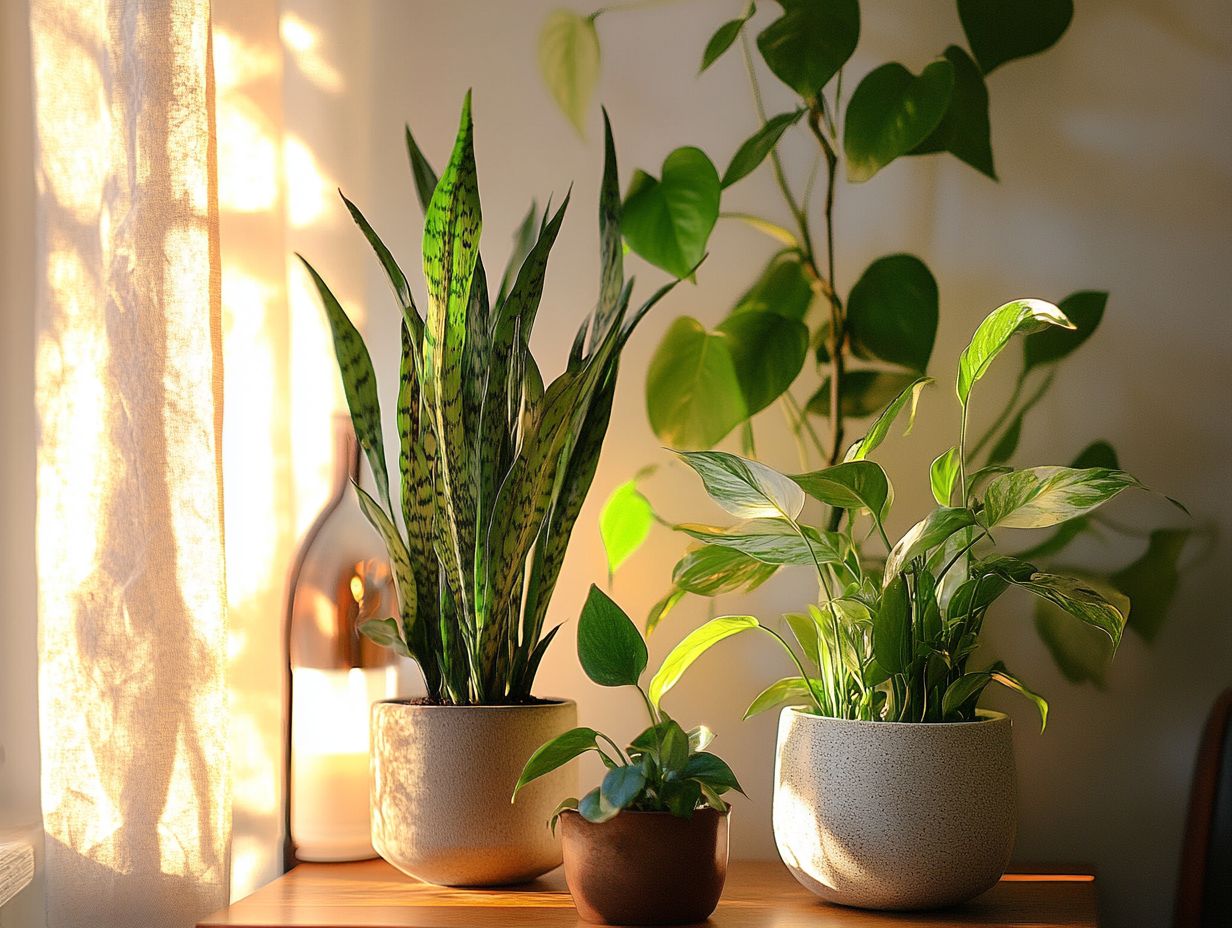
What are some top choices for low light indoor plants?
Some top choices for low light indoor plants include:
- Snake plants
- Peace lilies
- Pothos
- ZZ plants
- Chinese evergreens
- Philodendrons
Can low light indoor plants survive in rooms with no natural light?
Yes, some low light indoor plants can survive in rooms with no natural light. However, they may still need some form of artificial light, such as a grow light, to thrive.
Do low light indoor plants require any special care?
Generally, low light indoor plants require less maintenance compared to other plants. However, it is important to regularly check the soil moisture and provide adequate water and fertilization as needed.
Can I place low light indoor plants in high traffic areas?
Yes, low light indoor plants can be placed in high traffic areas as long as they are not exposed to direct sunlight or extreme temperature changes.
Which low light indoor plants are safe for pets?
Some low light indoor plants that are safe for pets include:
- Spider plants
- Boston ferns
- African violets
- Peperomia
Can I grow herbs in low light indoor conditions?
Yes, some herbs can be grown in low light indoor conditions, such as mint, parsley, and chives. However, they may not thrive as well as they would in bright light.

